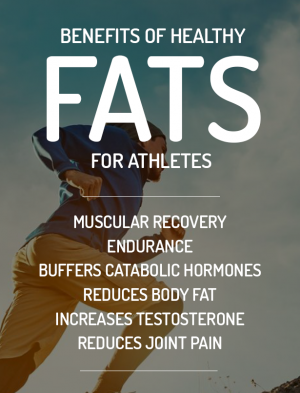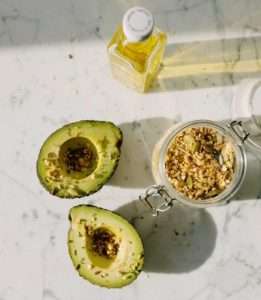May 7, 2025
I’m always asking questions. That’s my nature. I probably drove my mom crazy when I was a preschooler. Sorry, mom!
Curiosity is one thing. But now it matters to me on a different level – because I never want to overlook something that could be vital for the success, performance, and health of the people I work with.
So recently when I was working with a highly active female athlete whose daily calorie requirements are super high – we’re talking 3500 calories plus, and who I suspected might need more fats in her diet, I thought –
“But wait… 20-35% of total calories (the standard RDA for fats) is a lot of fat – is that too much for her?”
So I did what any conscientious modern-day professional would do, I asked chatgpt. Here’s the answer – I couldn’t have said it better myself!
(Scroll all the way to the bottom for all the reasons why healthy fats are so crucial for an athlete’s performance, recovery, body comp, and overall health).
✅ General RDA for Fat Intake
For the general population, the Acceptable Macronutrient Distribution Range (AMDR) for fat is:
-
-
20–35% of total daily calories.
-
This applies to most adults and includes both sedentary and moderately active individuals.
-
So for someone eating 3500 calories/day, that would be:
-
20% = 700 calories from fat ÷ 9 = ~78g fat
-
35% = 1225 calories from fat ÷ 9 = ~136g fat
🏃♂️ For Athletes: Is This Still True?
Yes—the percentage range still applies, but with nuance. Here’s why:
1. Fat Is Still Essential, Even at High Caloric Intakes
Athletes need fat for:
-
-
Hormone production (especially sex hormones)
-
Fat-soluble vitamin absorption (A, D, E, K)
-
Energy during long-duration, moderate-intensity activities
-
Brain and nerve function
-
Most sports nutrition guidelines agree that fat should not fall below 20% of total intake, even for weight-sensitive sports.
2. High-Calorie Diets Mean More Fat—And That’s OK
For an elite athlete eating 3500–5000 kcal/day, it’s not unusual to consume 100–150g of fat per day.
This is not considered excessive as long as:
-
-
Saturated fat is kept in check (under ~10% of total calories)
-
The fats come from healthy sources (e.g., nuts, seeds, avocado, olive oil, fatty fish)
-
Overall performance, digestion, and body comp goals are being met
-
3. Upper Limit?
-
There’s no strict upper gram limit, but going too high in fat (above the recommended 20-35% of total daily calories) could displace carbs or protein, which are more immediately performance-relevant, especially for high-intensity or anaerobic sports.
-
Ultra-endurance athletes sometimes push fat higher intentionally (e.g., 40%+) for metabolic adaptation, but that’s specific to endurance- based activities and not for all athletes.
🔬 What Leading Sources Say:
-
International Society of Sports Nutrition (ISSN): Recommends 20–35% fat for athletes, adjusted to personal needs and sport demands.
-
American College of Sports Medicine (ACSM): Agrees fat should be ~20–35% of total energy but emphasizes carbs as the priority for high-performing athletes.
-
IOC Consensus Statement on Sports Nutrition: Supports individualized fat intake, especially for energy balance, recovery, and long-term health.
✅ Bottom Line:
Yes, it’s totally appropriate (and even necessary) for high-level athletes eating 3500+ kcal/day to consume up to 135g of fat per day, provided:
-
It’s within the 20–35% range
-
It supports performance and recovery
-
It’s mostly unsaturated, nutrient-dense fats
There’s no strict upper gram limit, but balance matters—high fat shouldn’t crowd out the requirement for carbs or protein critical for performance.
But wait…
⚖️ Will 30% of 3500 Calories from Fat Cause Fat Gain?
Short answer: No, not if the athlete is in energy balance.
.
🔑 What Actually Causes Fat Gain?
-
Fat gain happens when total caloric intake is greater than caloric expenditure consistently—not just from eating more fat.
-
For athletes burning 3500+ calories a day through training and normal metabolism, eating 30% of that from fat (≈117g fat) is not excess—it’s proportionate.
-
The macronutrient ratio alone doesn’t cause fat gain—energy surplus does.
🏋️♀️ Athlete Example:
-
Calories in: 3500 kcal
-
Fat at 30%: 3500 x 0.30 = 1050 kcal → 1050 ÷ 9 = 117g fat
-
Calories out/burned: 3500 kcal (training, recovery, metabolism)
In this scenario, they’re in energy balance. No fat gain occurs, regardless of the fat grams eaten.
.
Now we know 🤓
Interested in working together so that we can dial in your personalized nutrition and macro needs? Get in touch today – this is my jam! And I promise, I won’t leave any stone unturned 👊🏼
Why Healthy Fats are Crucial to an Athlete’s Performance, Recovery, Body Composition, and Health
🧠 1. Energy Source & Endurance Performance
✅ Fats = Efficient Fuel for Long-Duration, Low-to-Moderate Intensity Exercise
-
Fat provides 9 kcal/gram, making it a dense energy source.
-
During prolonged aerobic activity, especially once glycogen stores dip, the body relies increasingly on fat oxidation.
-
Well-trained endurance athletes can use fat more efficiently, sparing muscle glycogen and delaying fatigue.
🔍 Evidence:
-
Jeukendrup & Aldred (2004) — Fat metabolism becomes more prominent in endurance sports as duration increases.
-
Hawley & Leckey (2015, Cell Metabolism) — Athletes adapt to increased fat oxidation with appropriate diet and training strategies.
🧬 2. Hormone Production & Regulation
✅ Fats Are Building Blocks of Hormones
-
Cholesterol and fatty acids are precursors for key steroid hormones (like testosterone, estrogen, cortisol).
-
Inadequate fat intake can disrupt hormonal balance, affecting muscle building, mood, and menstrual health (in women).
🔍 Evidence:
-
Low fat intake (<15–20% of calories) is associated with lower testosterone levels in male athletes.
(Volek et al., 1997; Forbes et al., 2014) -
In female athletes, chronic low fat (and energy) intake increases risk of Relative Energy Deficiency in Sport (RED-S) and menstrual dysfunction.
💪 3. Inflammation, Recovery & Injury Prevention
✅ Certain Fats Reduce Inflammation and Aid Recovery
-
Omega-3 fatty acids (EPA/DHA from fish oil) have anti-inflammatory effects.
-
They help reduce exercise-induced muscle soreness, enhance recovery, and may improve joint health.
🔍 Evidence:
-
Tartibian et al. (2009) — Omega-3 supplementation reduced delayed-onset muscle soreness (DOMS) after eccentric exercise.
-
Mickleborough (2013, J of Sports Science & Medicine) — Omega-3s may improve pulmonary function and reduce airway inflammation in endurance athletes.
🧠 4. Cognitive & Nervous System Function
✅ Fats Support Focus, Coordination, and Reaction Time
-
The brain is ~60% fat, and it relies heavily on omega-3s for cell membrane fluidity and neural signaling.
-
Proper fat intake can enhance mental clarity, focus during competition, and resilience to stress.
🔍 Evidence:
-
DHA is essential for cognitive performance and brain development (Gómez-Pinilla, 2008).
-
In athletes, improved omega-3 status is linked to better reaction time and decision-making under pressure.
🥗 5. Micronutrient Absorption
✅ Fat Enables Absorption of Fat-Soluble Vitamins (A, D, E, K)
-
These vitamins are vital for bone health, immune function, antioxidant defense, and muscle repair.
-
Low-fat or very low-calorie diets can impair absorption of these nutrients.
🔍 Evidence:
-
Mettler et al. (2009) showed that diets very low in fat (<15%) in athletes reduced fat-soluble vitamin absorption.
-
Vitamin D (fat-soluble) is crucial for muscle strength and immune health in athletes (Larson-Meyer, 2017).
⚖️ 6. Body Composition & Satiety
✅ Healthy Fats Support Lean Body Mass & Appetite Regulation
-
Despite being calorie-dense, fats can enhance satiety, reduce cravings, and stabilize blood sugar—important for body comp goals.
-
Adequate fat allows for muscle gain without hormonal compromise or overeating later from hunger rebound.
🔍 Evidence:
-
Moderate fat diets (25–30%) may be better for maintaining lean mass than low-fat (<15%) diets in strength athletes (Walberg-Rankin, 1992).
-
Omega-3s may promote fat oxidation and improve fat-free mass in resistance-trained individuals (Smith et al., 2011).
🩺 7. Long-Term Health & Athletic Longevity
✅ Fats Protect Heart, Joints, and Metabolic Function
-
Unsaturated fats (from olive oil, nuts, seeds, fatty fish) improve lipid profiles and reduce cardiovascular risk.
-
Long athletic careers require more than performance: joint integrity, brain health, and metabolic flexibility matter.
🔍 Evidence:
-
Mediterranean-style diets high in monounsaturated fats are linked to improved cardiovascular and cognitive outcomes (Estruch et al., 2013).
-
Chronic underconsumption of healthy fats is linked to injuries, burnout, and RED-S (Mountjoy et al., 2018).
🚫 What Happens with Too Little Fat?
| Consequence | Effect |
|---|---|
| ↓ Hormones | Lower testosterone, disrupted cycles |
| ↓ Energy availability | Increased fatigue, poor recovery |
| ↓ Vitamin absorption | Bone and immune health suffer |
| ↑ Inflammation | Slower recovery, joint pain |
| ↓ Cognitive function | Poor focus, irritability |
✅ Summary: Why Athletes Need Healthy Fats
| Benefit | How Healthy Fats Help |
|---|---|
| Energy & endurance | Fuel for long-duration training |
| Hormone balance | Supports testosterone, estrogen |
| Recovery & inflammation | Omega-3s reduce soreness and injury risk |
| Cognitive function | Supports focus and reaction time |
| Nutrient absorption | Aids in uptake of vitamins A, D, E, K |
| Body composition | Promotes satiety, preserves lean mass |
| Longevity | Protects heart, joints, and brain |
.
The Take-Away:
We talk a lot about the importance of carbs and protein for athletes, especially those who prioritize staying lean. But make sure you’re eating enough healthy fats – they matter too!
Wanna chat about how much of the different macros you should aim for to achieve your weight loss, muscle-building and/or performance goals? Check out RxMACROS, that’s what we do!
How much fat should an athlete eat?
The entire contents of this website are based upon the opinions of Build Holistic Nutrition. Please note that Build Nutrition is not a dietitian, physician, pharmacist or other licensed healthcare professional. The information on this website is NOT intended as medical advice, nor is it intended to replace the care of a qualified health care professional. This content is not intended to diagnose or treat any diseases. Always consult with your primary care physician or licensed healthcare provider for all diagnosis and treatment of any diseases or conditions, for medications or medical advice, as well as before changing your health care regimen.
© BUILD NUTRITION 2025. ALL RIGHTS RESERVED. PRIVACY POLICY
Go ahead, creep us on social. You know you want to!



